To Aleppo With Love – Introduction, Part 2
January 24th, 2015
Syrian cuisine in general, and especially Aleppine cuisine, has a very wide selection of dishes. Being surrounded by olive, nut and fruit orchards, Aleppo is famous for a love of eating, as the cuisine is the product of fertile land and location along the Silk Road. The International Academy of Gastronomy in France awarded Aleppo its culinary prize in 2007. But in fact, Aleppo was a food capital long before Paris, because of its diverse communities of Arabs, Kurds, Armenians, Circassians and a sizable Arab Christian population. All of those groups contributed food traditions, since Aleppo was part of the Ottoman Empire.
Aleppo prides itself on the best cuisine in the Middle East, the city has a vast selection of different types of dishes, and this post is just a brief introduction about Aleppine cuisine, everything here (dishes, or ingredients) are specialty of Aleppo.
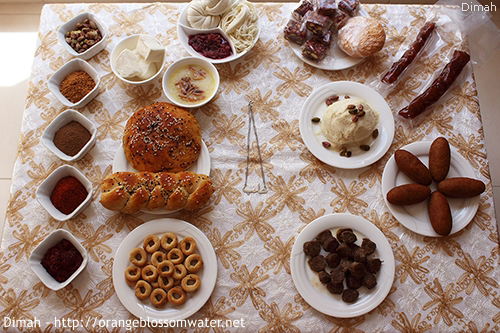
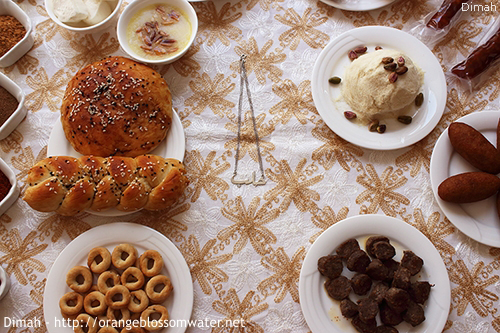
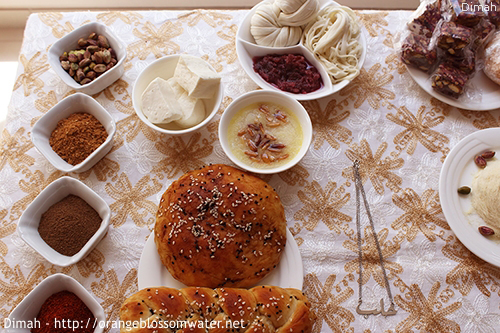
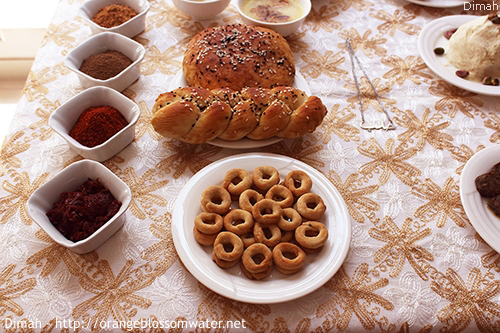
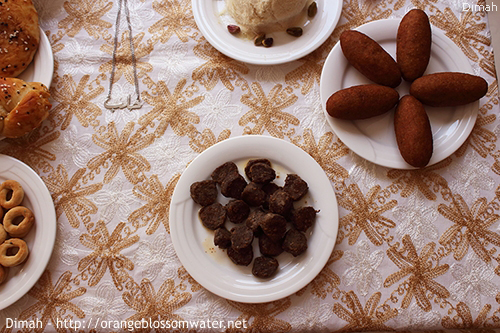
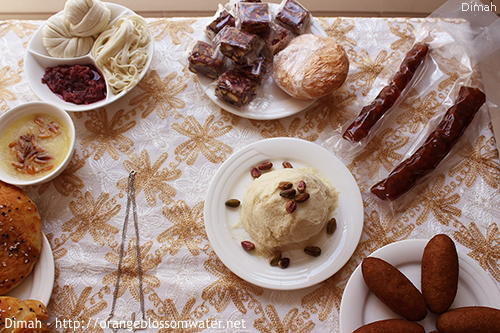
Most dishes or ingredients have in their name the word “Halabi” or “Halabiyeh”, this word means “From Aleppo”. Aleppo in Arabic is “Halab”, and “Halabi or “Halabiyeh” is derived from “Halab”.
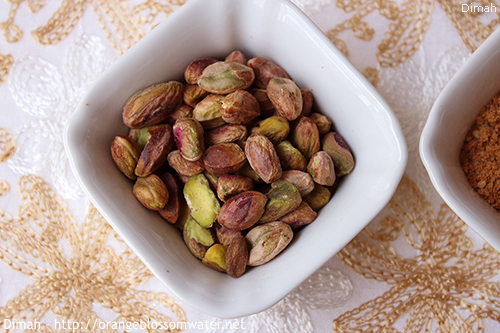
Above: Fustuq Halabi
The Syrian pistachio tree is known since Assyrians age. The origin of this tree goes back to Al-Batim Tree in the Mediterranean sea basin and Middle East regions; however, the original place of the Syrian pistachio is Syria (Ein Al-Tina). Many references refer to this kind as (Pistachio – Pistacia vera L.) known since 3500 years BC in West Asia and “Great Syria” countries. The Aleppo pistachio is attributed to Aleppo city which is the traditional area for planting this tree since long ages; therefore, whenever Aleppo city is mentioned, we have to mention the Aleppo pistachio (Fustuq Halabi). In Aleppo, the pistachio blossomed producing a dozen varieties, a unique diversity. These varieties differ both in the color and the size of the fruit on the tree. As the taste and scent, the soil and position of the trees provide the variations. Pistachio is important ingredient in the traditional cuisine of Aleppo.
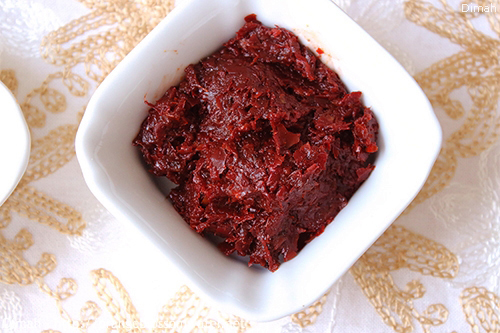
Above: Dibs Al-Fleifleh Al-Halabiyeh دبس الفليلفة الحلبية
Dibs Al-Fleifleh Al-Halabiyeh is red pepper paste made from Aleppo Pepper (a variety of Capsicum annuum). It is prepared in summer (July and August). Aleppo pepper is de-seeded, then spread in trays and left outside in sun until semi-dry. Then it is ground using a meat grinder with the medium holed plate attached, then seasoned with coarse salt for preservation, and kept in bags in freezer or mixed with olive oil and stored in jars covered with olive oil and kept in fridge.
Dibs Al-Fleifleh Al-Halabiyeh is widely used in Aleppine recipes like Manaqish as you see in the picture, Kibbeh Naiyeh Bi-Zeit Az-Zeitoun, Itch, Bathenjan Mshattah, Mhammara, Lahm Bi-‘Ajin, and others.
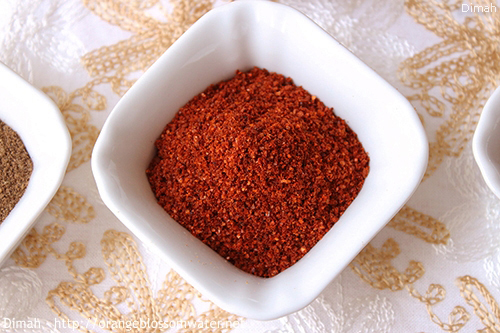
Above: Flaifleh Halabiyeh Matthoneh فليفلة حلبية مطحونة
Flaifleh Halabiyeh Matthoneh (Ground Aleppo Pepper) is made from Aleppo Pepper (a variety of Capsicum annuum). It is prepared in summer (July and August). Aleppo pepper is de-seeded, then spread in trays and left outside in sun to fully dry. Then it is ground using a grinder, then mixed with fine salt for preservation and stored in jars in cool dry place or in fridge, and it is used in many dishes.
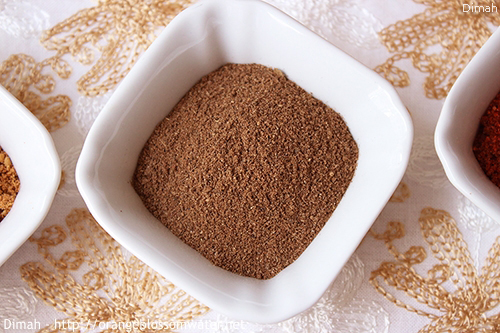
Above: Al-Bhar Al-Halabi, Bhar Al-Daqqa Al-Halabi البهار الحلبي، بهار الدقة الحلبي
Al-Bhar Al-Halabi is a mixture of spices which is only available in Aleppo and widely used in Aleppine dishes.
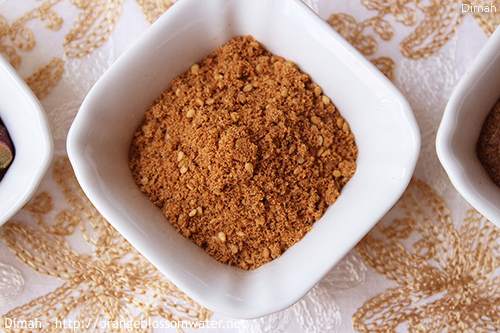
Above: Za’tar Halabi زعتر حلبي
Aleppo is very famous for Za’tar mix (Thyme mix). In Aleppo, Za’tar is prepared by blending ground thyme leaves with spices (anise, coriander, fennel, cumin), and with (terebinth, peanuts, watermelon seeds, cantaloupe seeds “sometimes other kind of seeds are used”), this mixture is ground using grinder, then sumac and sesame seeds are added. Za’tar Halabi is slightly sour, salty, warming, aromatic, and less pungent than other mixes. It is eaten with olive oil.
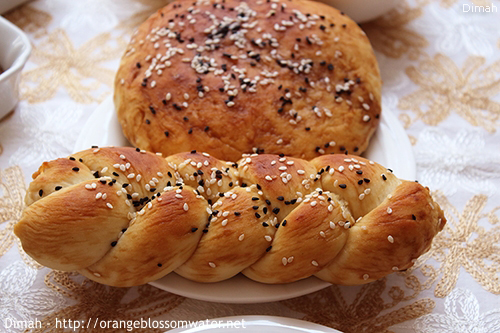
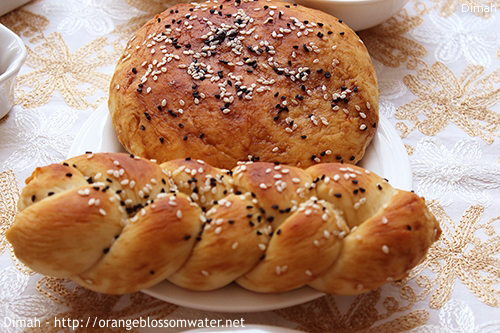
Above: Ma’rouk Ramadan (Ma’rouk Halab / Ma’rouk Halabi) معروك رمضان، معروك حلب / معروك حلبي
Ma’rouk is a sweet bread available during the holy month of Ramadan. It can be eaten plain, or the bread can be stuffed with (cheese, date paste, chocolate…).
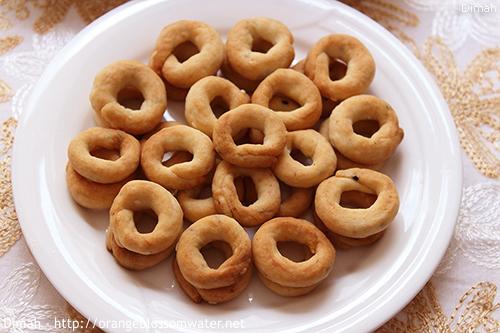
Above: Ka’ek Al-Eid / Ka’ek Bi-Mait Al-Jebenh كعك العيد/ كعك بمية الجبنة
Ka’ek Al-Eid is salty cookies seasoned with (mahlab, anise, fennel, and cumin). The dough is mixed with sesame seeds and nigella seeds.
Ka’ek Bi-Mait Al-Jebneh is similar to Ka’ek Al-Eid in shape, but without the spices, and prepared with (salty water of cheese, the cheese used is either Jebneh Mshallaleh (Syrian string cheese) or Jebneh Biada Baladiyeh), this will be clear when I’ll post the recipe.
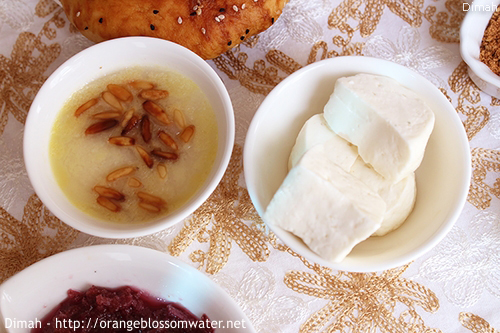
Above: Mamouniyeh مامونية
Mamouniyeh is a sweet breakfast dish like porridge made with semolina, sugar, water and ghee and garnished with cinnamon and pine nuts. It is served with cheese (Jebneh Mshallaleh (Syrian string cheese) or Jebneh Biada Baladiyeh), and with Sha’eebbiyat .
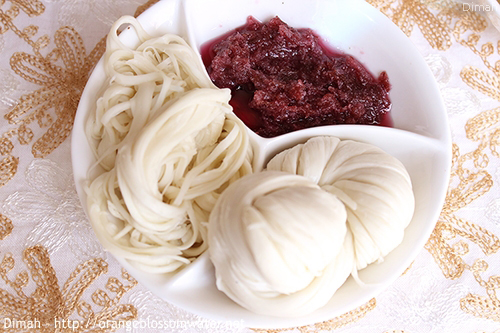
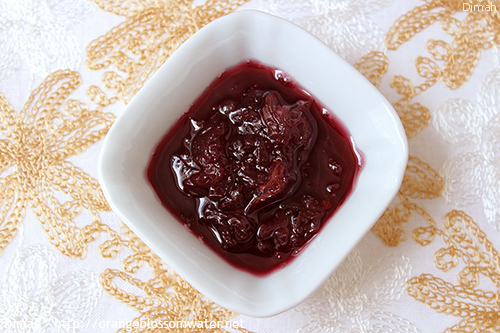
Above: Mrabba Al-Ward مربى الورد
Mrabba Al-Ward (Rose Jam), famous in Aleppo made of Damask Rose Petals (ورد الجوري السبيعي), jam is served with cheese (Jebneh Mshallaleh (Syrian string cheese) or Jebneh Biada Baladiyeh).
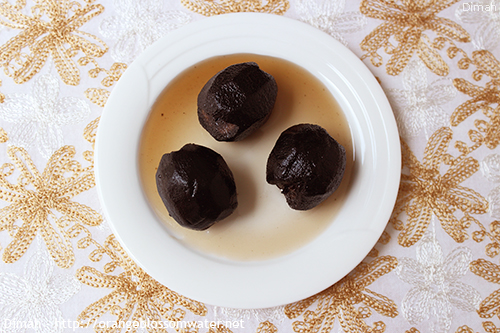
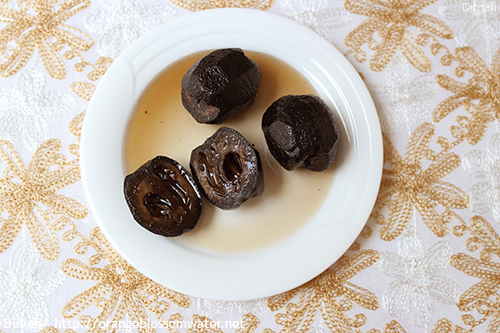
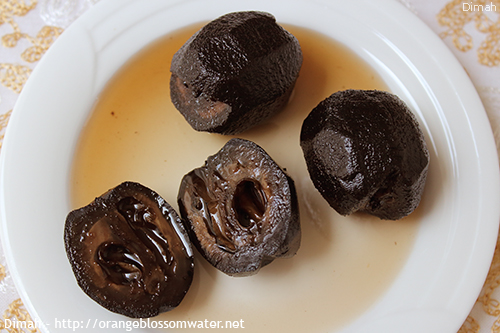
Above: Mrabba Al-Jouz مربى الجوز
Mrabba Al-Jouz (Walnut Preserve), is a specialty of Aleppo, made from early, green walnuts. Cloves and cinnamon are added during preparation. Walnut preserve is highly prized, as its preparation is laborious and time-consuming.
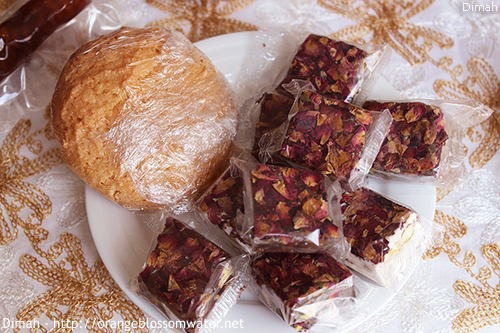
Above: Left: Diafet Jouz Al-Hind ضيافة جوز الهند
Above: Right: Raha Bel-Ward راحة بالورد
Diafet Jouz Al-Hind is oval or round shape sweets made with coconut, meringue and sugar, they’re baked as biscuits then joined together, and served in celebrations (specially at weddings).
Raha Bel-Ward is Turkish delight with pistachios and coated with Damask Rose Petals.
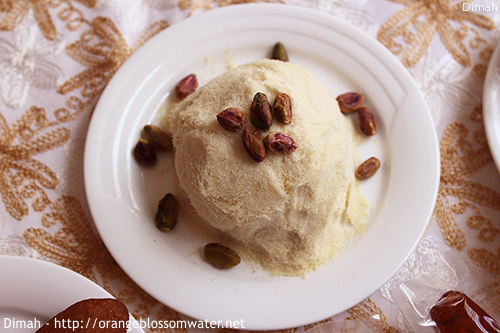
Above: Ghazel Al-Banat غزل البنات
The ultimate Ramadan exclusive, Ghazel Al-Banat, fluffy white clouds of spun sugar, that melt in your mouth, only to surprise you with toasted Aleppo pistachios suspended in the nest of sweet threads, also it is available plain or stuffed with Qashta (milk cream). The photo above is Ghazel Al-Banat but not exactly the same shape that is available in Aleppo (I couldn’t find it), here is a photo from the net showing the exact shape of Aleppine Ghazel Al-Banat
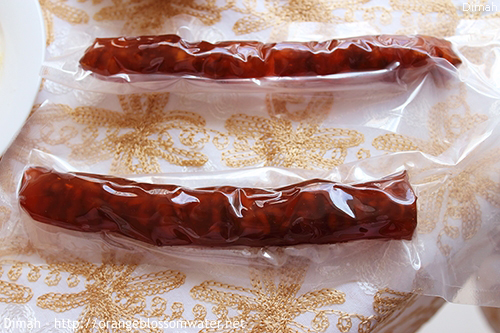
Above: Al-Jeq Malban, Al-Je’ Malban الجق ملبن، الجئ ملبن
Al-Jeq Malban (in Turkish: Cevizli Sucuğu). Al-Jeq Malban is made with walnut halves threaded onto cotton strings and dipped in boiled grape juice which is thickened by adding cornstarch. The walnut “ropes” are tied onto a metal ring and dipped again and again into the hot boiled grape juice until they are thickly coated, then they are hung to dry. It can be prepared at home, and grape molasses can be used if grape juice is not available, I’ll show you the recipe later.
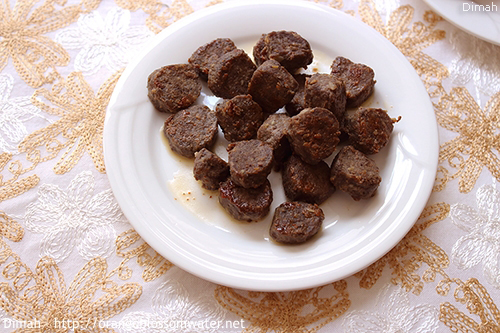
Above: Sujuq سجق
Sujuq is Sausage, it is fatty minced meat mixed with garlic and spices (Al-Bahar Al-Halabi, ground Aleppo pepper, curry, cumin, coriander, black pepper, salt). This mixture is kept in a bag made of cloths, and allowed to air-dry in a cool place. You can eat sujuq in different ways, for example it’s popular to make sujuq sandwiches with pita bread, or to use it over pizza. I’ll post the recipe with ideas soon.
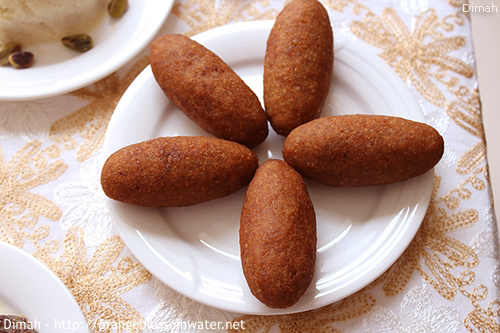
Above: Kibbeh Darawish كبة دراويش
Kibbeh dough is prepared with extremely lean ground lamb kneaded with bulgur wheat (cracked wheat) until a dough is formed. In “The Encyclopedia of Aleppo”, it is mentioned that in Aleppo there are more than 60 kinds of Kibbeh. That is why Aleppo is known as “the home of stuffed vegetables and kibab (plural of kibbeh) حلب أم المحاشي و الكبب.
Kibbeh Darawish is a type of Kibbeh Meqliyeh (deep fried kibbeh). Kibbeh Darawish is known for the shape which you see in the photo, also in Aleppo the filling is seasoned with Al-Bahar Al-Halabi.
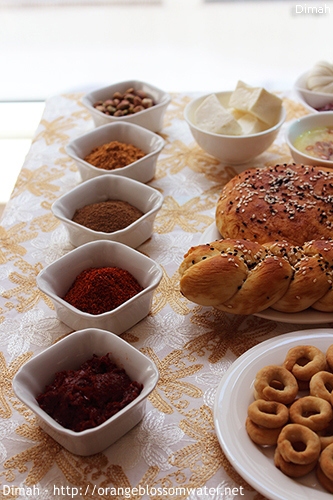
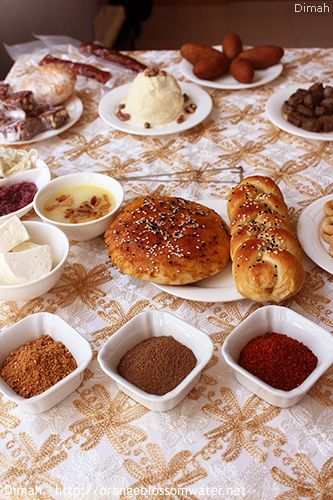
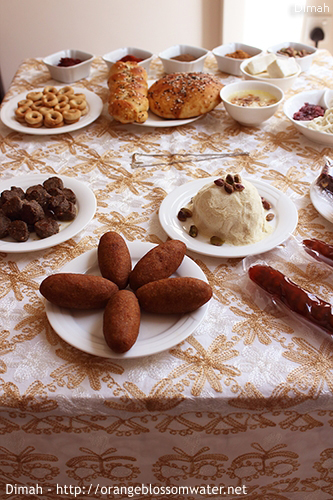
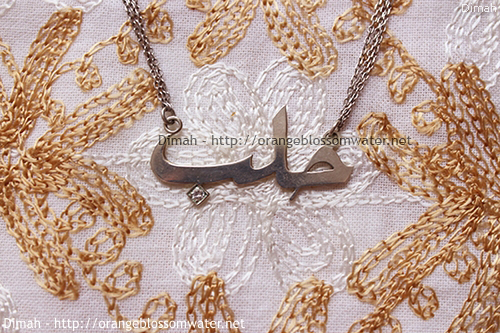
More examples of Aleppine Dishes / Food / Ingredients:
– Bastirma بسطرما : air-dried cured beef surrounded with ground Aleppo pepper and chaman, a pungent spice. Armenian in origin.
– Martadella Halabiyeh مرتديلا حلبية : very fine ground meat “Habra” mixed with spices, garlic, peeled pistachios then rolled into a thick sausage shape. The meat is smoothed by hand then boiled in water and vinegar. Cut into rounds and served cold.
– Lahmeh Bi-Karaz لحمة بكرز : lean minced meatballs cooked with small sour cherries (washneh) and spices. Served on pieces of Arabic bread cut in triangles and scattered with pine nuts and parsley.
– Kabab Khashkhash كباب خشخاش : fatty minced meat mixed with hot peppers, parsley, and crushed garlic, then shaped into kabab and grilled, served on a bed of tomato sauce.
– Bastiq بصطيق : sheets of grape paste, spread on fabric, and dried.
– Ghraibeh Estanbouliyeh (Ghraibet Al-Louz) غريبة اللوز الإسطنبولية: oval or round shaped sweets made with almonds, meringue and sugar, they’re baked as biscuits then joined with a chocolate or pistachio paste.
– Sharab Al-Louz شراب اللوز : is a drink made with almonds, milk and sugar, served in celebrations (specially at weddings).
Aleppo “history, heritage, cuisine” need thousand pages and still not enough. Of course, I didn’t cover everything here but you will discover more about Aleppo and the food when I publish Aleppine recipes.
Read “Part 1” here: To Aleppo With Love – Introduction, Part 1
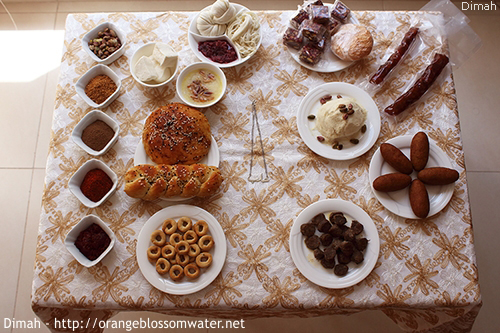

Salam,
Tiens ! Je reconnais le fromage que j’achète chez un Syrien à Alger.
Tu sais, moi, cela fait près de 23 ans que je n’ai pas mis les pieds à Tehran ! Et cela me manque !
salam
sarvenaz: Thank you so much for stopping by and for the comment. Salam
Everything looks splendid!! As I said I have heard great things about the cuisine of Aleppo and I believe Syrian food had more flavor and use of interesting ingredients that reflect the region. For example the use of rose petals (common in Iran and Afghanistan as well), and lots of use of pomegranate syrup which I see less in other Arab cuisines. And ofcourse the Kibbeh….every time I have Kibbeh at a Syrian friends home it tastes different as there are so many ways to prepare it!! Hope I can one day try the Zatar mix, as it is quite different from what we buy. I have had the Aleppo pepper paste, and it is very distinct in taste, great way to make a dish distinctive. Thank you again for sharing :-)
MyKabulKitchen: Thank you very much for your stopping by and for your kind words.
I’ve pomegranate molasses recipe if you like to check it (http://www.orangeblossomwater.net/index.php/2013/01/01/debs-ar-remman/), also I’ll post the recipe of Za’atar mix InshAllah soon.
Thank you for reading my blog, much appreciated ♡
How lovely to read your blog, that brings such wonderful memories back to me. Let us hope that peace will come soon to your tortured city.
Perhaps you can help. last time I was in Syria, I had some cheese from Ma’ara which was boiled before being eaten. I was told that it was a speciality of that town and I certainly have never tasted anything like it. It was absolutely delicious. I don’t know its name.
Judy C: Thank you so much for stopping by and for you nice words, much appreciated.
Here is a post about some kinds of cheeses in Syria, I guess you are talking about “Jebneh Baladiyeh” (it is known in most Syrian cities), take a look http://www.orangeblossomwater.net/index.php/2010/02/05/jebneh/
Thanks Dimah. Your blog is so interesting and a treasure trove for anyone interested in Syrian cuisine. I think you are probably right that the cheese I am thinking of is jibneh baladiyeh, though it was not salty.
One of the pleasures of my last trip to Aleppo was shopping with the driver who was from Damascus and who was a gourmet. He knew which shop to go to for the best pistachios, the best za’atar, bread, sweets,foul, honey, camomile and truffles. We went to Ma’ara specifically for the cheese though it was not on the itinerary. I was thrilled to visit the town because I loved the poetry of al-Maari but when I tasted the cheese, I was even more happy. Look after yourself.
I Love your blog Dimah it’s so beautiful and useful….And like your cooking and decoration…I want to ask you where can l find the cover of your table out syria it’s fabulous
Zoya: Thank you so much for you kind words.
I live in Dubai and I remember that the cover of table is available in (the Syrian Pavilion at the Global Village). Unfortunately, I have no idea where you would find it in other countries.
Thank you very much Dimah… Nice to meet you…..l live in Bahrain…Inshallah l will go to Dubai soon and l want to see you..
Zoya: Inshallah :-)
Hi Dimah,
Your presentations & explanations are so interesting! You make me so sad & homesick about Aleppo…may God bless the people & the city.
Thank you for the historic anecdotes with each delicious recipe.
Ghalia
I am so thankful and honored to have stumbled upon your site. What a treasure trove of recipes (and so precise and detailed), wonderfully beautiful and sad photos evoking tremendous emotions. Thank you so much for putting this together. A lovely dedication to your families cooking and to your Country.
And to think I found you all because i found some beautiful baby eggplants today that triggered a craving for my Mothers Makdous. Actually the recipe she made was given to her by her dear Syrian friend. :-). Will be my first attempt!
Rizan ♡♡♡
I have to say I’m speechless….thank you. I’m blessed that you enjoyed reading my blog. It’s comments like these that motivate me to keep doing what I do.
Thank you so much for your support.